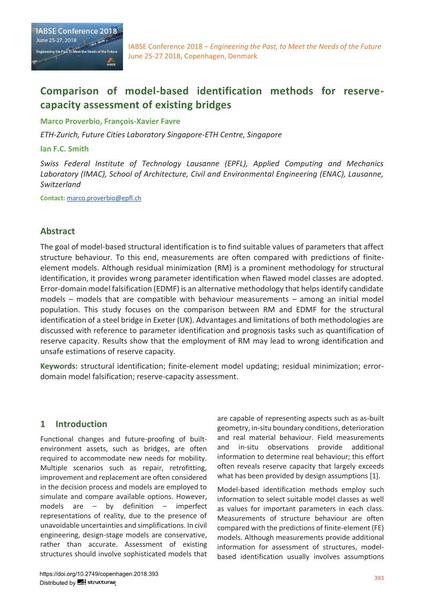mparison of model-based identification methods for reserve-capacity assessment of existing bridges

|
|
|||||||||||
Détails bibliographiques
| Auteur(s): |
Marco Proverbio
(ETH-Zurich, Future Cities Laboratory Singapore-ETH Centre, Singapore)
François-Xavier Favre (ETH-Zurich, Future Cities Laboratory Singapore-ETH Centre, Singapore) Ian F. C. Smith (Swiss Federal Institute of Technology Lausanne (EPFL), Applied Computing and Mechanics Laboratory (IMAC), School of Architecture, Civil and Environmental Engineering (ENAC), Lausanne, Switzerland) |
||||
|---|---|---|---|---|---|
| Médium: | papier de conférence | ||||
| Langue(s): | anglais | ||||
| Conférence: | IABSE Conference: Engineering the Past, to Meet the Needs of the Future, Copenhagen, Denmark, 25-27 June 2018 | ||||
| Publié dans: | IABSE Conference Copenhagen 2018 | ||||
|
|||||
| Page(s): | 393-400 | ||||
| Nombre total de pages (du PDF): | 8 | ||||
| DOI: | 10.2749/copenhagen.2018.393 | ||||
| Abstrait: | The goal of model-based structural identification is to find suitable values of parameters that affect structure behaviour. To this end, measurements are often compared with predictions of finiteelement models. Although residual minimization (RM) is a prominent methodology for structural identification, it provides wrong parameter identification when flawed model classes are adopted. Error-domain model falsification (EDMF) is an alternative methodology that helps identify candidate models – models that are compatible with behaviour measurements – among an initial model population. This study focuses on the comparison between RM and EDMF for the structural identification of a steel bridge in Exeter (UK). Advantages and limitations of both methodologies are discussed with reference to parameter identification and prognosis tasks such as quantification of reserve capacity. Results show that the employment of RM may lead to wrong identification and unsafe estimations of reserve capacity. | ||||
